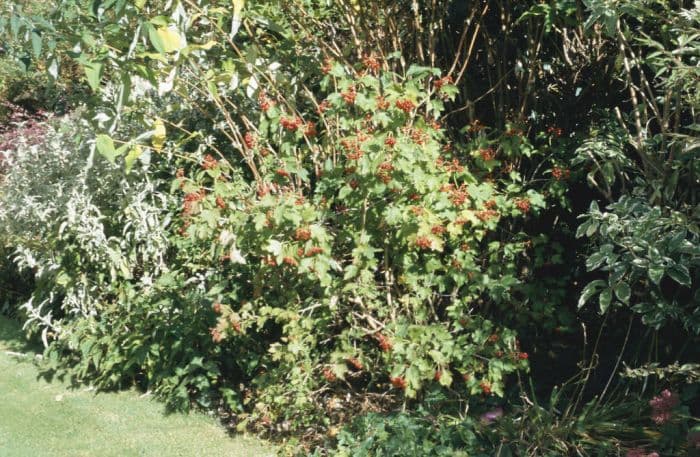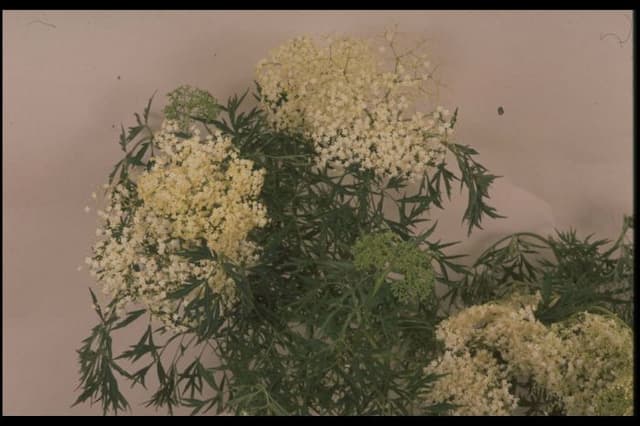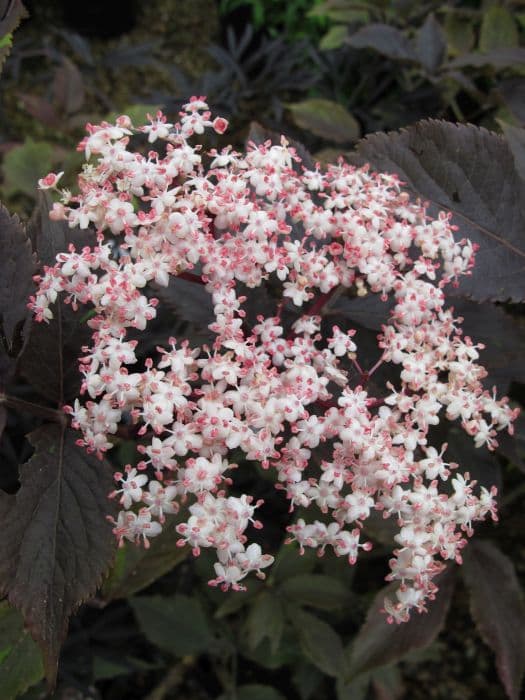European Cranberrybush Viburnum opulus 'Compactum'

ABOUT
The plant commonly known as the Compact European Cranberrybush is a dense, rounded shrub characterized by its attractive foliage and showy flowers. The leaves are maple-like in shape, with a rich green color that often turns a brilliant red in the fall, providing a striking autumn display. In spring, the plant is adorned with large, white, lace-cap flowers that are both eye-catching and fragrant. These blossoms give way to clusters of bright red berries which can last well into winter, adding interest to the garden and attracting wildlife such as birds. The bark of the plant is relatively smooth with a greyish hue. Overall, the Compact European Cranberrybush presents a lush and vibrant appearance that can offer multi-season interest to any garden or landscape setting without discussing its specific size dimensions.
About this plant
 Names
NamesFamily
Adoxaceae
Synonyms
European Cranberry Bush, Guelder Rose, Compact European Cranberrybush, Dwarf Guelder Rose
Common names
Viburnum opulus var. nanum.
 Toxicity
ToxicityTo humans
Guelder Rose (Viburnum opulus 'Compactum') is considered mildly toxic if ingested. The primary concern with ingestion is the presence of compounds like viburnin and hydrocyanic acid in the plant's bark and leaves, and less so in the berries. Symptoms of poisoning can include nausea, vomiting, diarrhea, and stomach cramps. In severe cases, consuming large quantities can potentially lead to more serious symptoms such as dizziness, weakness, and in extremely rare cases, seizures. However, poisoning from Guelder Rose is relatively uncommon, as the unpleasant taste of the plant parts usually discourages ingestion in significant amounts.
To pets
Guelder Rose (Viburnum opulus 'Compactum') poses a similar risk to pets as it does to humans, with the potential to cause mild toxicity if ingested. The toxins involved can affect a pet's gastrointestinal system leading to symptoms like vomiting, diarrhea, and abdominal pain. In rare cases, if a pet consumes a large amount of the plant, especially the bark or leaves which contain higher concentrations of the toxic compounds, it may experience more severe symptoms such as lethargy, drooling, and in very severe cases, seizures or collapse. As pets often explore with their mouths, it is advisable to prevent them from chewing on this plant to avoid any negative health effects.
 Characteristics
CharacteristicsLife cycle
Perennials
Foliage type
Deciduous
Color of leaves
Green
Flower color
White
Height
4-6 feet (1.2-1.8 meters)
Spread
4-6 feet (1.2-1.8 meters)
Plant type
Shrub
Hardiness zones
3-8
Native area
Europe Asia
Benefits
 General Benefits
General Benefits- Aesthetic Appeal: Adds visual interest to gardens with its dense, mounded form and attractive foliage.
- Seasonal Interest: Offers year-round interest with white spring flowers, red autumn berries, and vibrant fall foliage color.
- Wildlife Habitat: Provides food and shelter for birds and beneficial insects.
- Compact Size: Suitable for small gardens or spaces due to its smaller growth habit relative to other Viburnum varieties.
- Low Maintenance: Requires minimal pruning and is generally easy to care for once established.
- Tolerant of Various Conditions: Adapts to a wide range of soil types and can handle full sun to partial shade exposures.
 Medical Properties
Medical Properties- Antispasmodic: Crampbark (the common name of Viburnum opulus 'Compactum') may help to relieve muscle spasms and cramps.
- Diuretic: It has been used traditionally to increase urine production and relieve fluid retention.
- Sedative: Some components of Crampbark may have a calming effect on the nervous system.
- Astringent: This plant is thought to have properties that can help to tighten and tone tissues.
 Air-purifying Qualities
Air-purifying QualitiesThis plant is not specifically known for air purifying qualities.
 Other Uses
Other Uses- Viburnum opulus 'Compactum', also known as Guelder Rose, can be used in making natural dyes for fabrics, with different parts of the plant providing various shades.
- The densely twiggy branches of Guelder Rose can be used to create intricate natural sculptures for garden art.
- The wood of the Guelder Rose is strong for its size and can be fashioned into small items like tool handles or carved ornaments.
- During winter, the snow-covered bare branches of Guelder Rose can add aesthetic value to a wintry garden landscape.
- The Guelder Rose can act as a natural screen or hedge in gardens, providing privacy without the use of artificial fencing.
- Guelder Rose berries, although not palatable for humans, can be used in making bird food mixtures to attract wildlife to the garden.
- The Guelder Rose's resilient characteristics make it suitable for stabilizing soil and controlling erosion on slopes or riverbanks.
- For photographers and artists, the Guelder Rose provides a picturesque element in capturing the essence of each season through its changing foliage and fruit.
- In educational settings, the Guelder Rose can be used as a learning tool for horticulture students studying plant growth and pruning techniques.
- Viburnum opulus 'Compactum' can be incorporated into a sensory garden, where its leaves and textured bark provide unique tactile experiences.
Interesting Facts
 Feng Shui
Feng ShuiThe European cranberrybush is not used in Feng Shui practice.
 Zodiac Sign Compitability
Zodiac Sign CompitabilityThe European cranberrybush is not used in astrology practice.
 Plant Symbolism
Plant Symbolism- Protection: In some cultures, the Viburnum opulus, commonly known as European cranberrybush, is believed to offer protection against negative forces and was often planted near homes for this purpose.
- Unity: The interconnectedness of the bush's branches and dense foliage are sometimes seen as a symbol of family unity and togetherness.
- Bounty: The plant's generous production of berries has been taken as a sign of abundance and to represent the idea of providing for one’s family.
- Good Health: The medicinal properties historically attributed to parts of the plant, especially the berries which have been used in traditional medicine, symbolize well-being and the maintenance of good health.
- Renewal: As a deciduous shrub that blooms in the spring, the European cranberrybush is often associated with new beginnings and the renewal of life.
 Water
WaterThe European Cranberrybush (Viburnum opulus 'Compactum') requires consistent moisture, so it should be watered thoroughly when the top inch of soil feels dry to the touch. Generally, this may mean watering once a week, but this can vary depending on climate conditions, with more frequent watering necessary in hotter, drier periods. When you water, apply enough so that the water reaches the roots deeply rather than just wetting the surface; this could mean using about 1 to 1.5 gallons per watering for a medium-sized shrub. During the winter months or in cooler climates, reduce the frequency to match the plant's decreased water needs. Always ensure there is adequate drainage to prevent waterlogging, which can be detrimental to the shrub's health.
 Light
LightThe European Cranberrybush prefers full sun to partial shade conditions. It thrives best in a location where it can receive at least four to six hours of direct sunlight daily. However, in regions with very hot summers, some afternoon shade can be beneficial to prevent scorching. The ideal spot would be one that gets bright morning sun with some protection from the intense midday heat, ensuring vibrant foliage and abundant flowering.
 Temperature
TemperatureThe European Cranberrybush is quite cold hardy and can tolerate temperatures down to -30°F, making it suitable for many temperate climates. The plant performs best in the temperature range between 60°F and 75°F but can withstand summer highs up to around 85°F without stress. Winter hardiness and tolerance for cold make it an excellent choice for gardeners in cooler regions who desire a resilient ornamental shrub.
 Pruning
PruningThe European Cranberrybush requires pruning to maintain its shape, remove any dead or diseased wood, and encourage healthy growth. Pruning should be done after the shrub has finished blooming in late spring or early summer to avoid cutting off the next year's flower buds. It's best to thin out old branches rather than shearing the shrub, to keep its natural shape. On average, prune every 2 to 3 years to keep the plant vibrant and well-ventilated.
 Cleaning
CleaningAs needed
 Soil
SoilGuelder Rose or European Cranberrybush (Viburnum opulus 'Compactum') thrives in well-draining, fertile soil rich in organic matter with a pH of 5.5 to 6.5. An ideal soil mix might include loam, peat, and perlite to ensure good drainage and moisture retention.
 Repotting
RepottingEuropean Cranberrybush doesn't require frequent repotting; repot it every 3 to 5 years to refresh soil and to accommodate root growth.
 Humidity & Misting
Humidity & MistingEuropean Cranberrybush prefers moderate humidity but is quite adaptable to various levels provided the other growing conditions are met.
 Suitable locations
Suitable locationsIndoor
Place in bright indirect light, ensure good air flow, don't overwater.
Outdoor
Full sun to partial shade, shelter from high winds, mulch roots.
Hardiness zone
4-8 USDA
 Life cycle
Life cycleViburnum opulus 'Compactum', commonly known as the Compact European Cranberrybush, begins its life cycle as a seed, which germinates in spring when soil temperatures rise and moisture is adequate. The seedling emerges and establishes itself, developing a root system and foliage during the first growing season. In subsequent years, it enters a vegetative stage, growing into a dense, compact shrub with a rounded form, reaching maturity in several years. The plant blooms in late spring to early summer, producing white flowers that attract pollinators, followed by bright red berries that persist into winter, providing food for birds and wildlife. After flowering, it undergoes pollination, either by self-fertilization or cross-pollination with another Viburnum opulus plant, leading to the production of seeds which completes the reproductive cycle. Over many years, the shrub will eventually reach senescence, where growth slows, and it may become susceptible to disease or environmental stress before dying, at which point it returns nutrients to the soil as it decomposes.
 Propogation
PropogationPropogation time
Spring-Early Summer
The most popular method for propagating Viburnum opulus 'Compactum', commonly known as the European Cranberrybush, is softwood cuttings. This is generally done in late spring or early summer, when new growth is still tender and pliable. To propagate, cut a section from the current year's growth that includes at least two sets of leaves, making sure the cutting is about 4 to 6 inches (10 to 15 centimeters) long. Remove the leaves from the lower half of the cutting and dip the cut end into a rooting hormone. Plant the cutting in a well-draining rooting medium, such as a mix of peat and perlite, and maintain consistent moisture. Cover the cutting with a plastic bag or place it in a propagator to maintain high humidity. With proper care, roots should develop within a few weeks, after which the cuttings can be gradually acclimatized to less humid conditions before transplanting.









